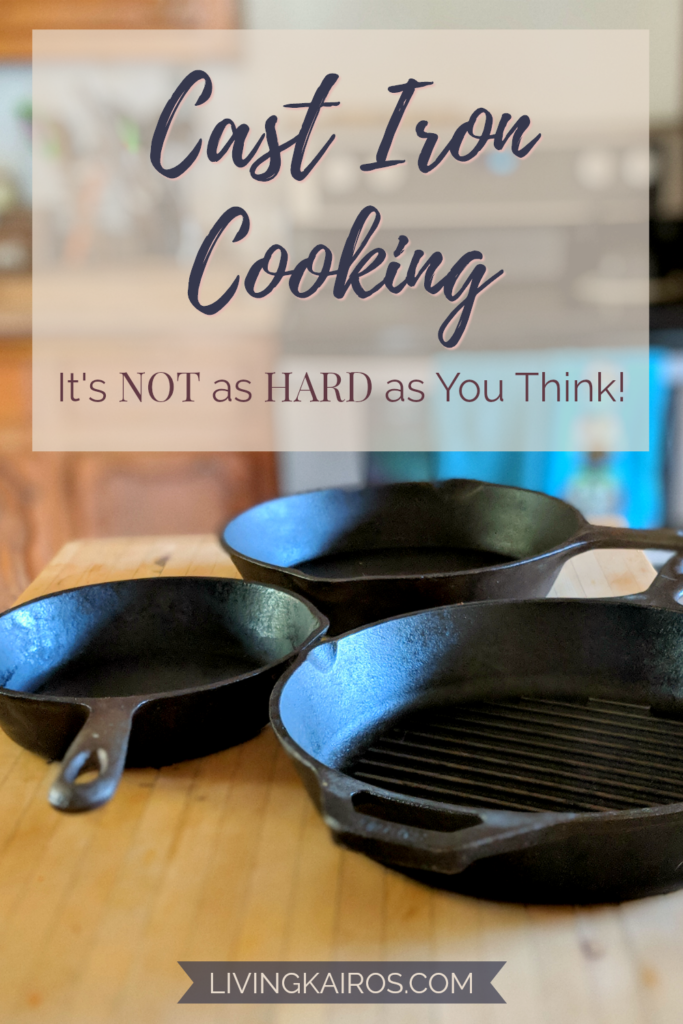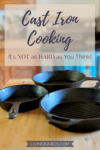Today we are going a little off-topic for Living Kairos and venturing into the world of cooking. You probably realize that this is not a food blog, but I wanted to share one of my favorite cooking methods with you: cast iron cooking. You probably remember your grandmother cooking on her cast iron skillet, and maybe she even passed it on to you. But many women today have no idea how to care for or cook with a cast iron skillet. So today, I am going to share how to do both, and hopefully get you excited to dig out that old skillet and get cooking.

Why cook with cast iron?
Cast iron cooking seems like a lot of hassle to many people. I mean, you’ve got to season your cast iron (whatever that means, right?), clean it in a special way, and be careful it doesn’t rust. So why would anyone want to do that when there are so many other options?
It lasts forever
Remember we talked about your grandmother cooking with cast iron back in the day? Well chances are, that piece was probably passed down to her from her mother or grandmother. Cast iron is amazing because, with the proper care, it can last forever! In many families, cast iron pieces are heirlooms.
It gets better with age
Cast iron cookware is unique in that, unlike other types of cookware, it gets better with age. The more you use each piece, the more non-stick it becomes. It’s pretty indestructible, so you don’t have to worry too much about breaking it or melting the handle like you would with other cookware (been there, done that).
It makes food taste delicious
I feel like I would use cast iron just for how amazing it makes my food taste. And don’t worry, it doesn’t taste metallic! When a piece of cast iron cookware is seasoned really well, those flavors transfer right into the food, creating a one-of-a-kind dish. Cast iron also retains heat very well, so your food will stay warm almost forever.
Cast iron care
This is the part that turns a lot of people off from cast iron cooking. While the care does take a little extra time, it’s really not that bad.
Pre-seasoning your cast iron
Pre-seasoning should only be done if you have a cast iron piece that is completely rusted out and otherwise unusable. If you pull your skillet from a box in the attic and it’s full of rust and charred-on food, you’ll want to strip it before trying to season.
To pre-season your cookware for cast iron cooking, use a hard, metal dish scrubber (stainless steel works well) and soap to get all the rust and gunk off. This is the only time you should ever use soap when cast iron cooking. Put some serious elbow grease into it, because you basically want to start with a clean slate.
Seasoning your cast iron
Once your cast iron is completely stripped and dry, you can start seasoning your pan. Seasoning is what makes your cast iron non-stick, and what gives your food that yummy flavor.
I season my cast iron with bacon grease, and I’ve found it works better than any other types of grease that I have tried. Plus I get bacon out of the deal.
Preheat your oven to 250 degrees Fahrenheit. Start by cooking some yummy bacon in your cast iron skillet. I always cook mine low and slow so I get the maximum amount of fat without burning it. Remove the bacon and set it aside (or eat it right then; I’m not judging). Strain the grease through a metal strainer into a jar or bowl, and use a paper towel to get all the little bits of bacon out of the pan before continuing.
Next, pour a little bacon grease onto a paper towel and rub the entire pan, including the sides, handle, and outside. Put the pan in the oven and set the timer for one hour.
After an hour, take the cast iron cookware out of the oven (carefully!). Let it cool for a few minutes, and then rub more grease all over the pan. Put it back in the oven for another hour.
Repeat this process at least three times, but the more you do it, the better-seasoned your cast iron will be. I usually do this on a Saturday when I’m going to be home all day.
When you take the cast iron out of the oven for the last time, rub it one more time with bacon grease. Let it cool and then put it away. Congratulations! You just seasoned your cast iron cookware!
Cleaning and maintenance
It’s very important to correctly clean and care for your cast iron. Never, ever use soap to clean it, because the de-greasing properties in soap will undo all the good seasoning you did. Instead, use a paper towel to get all the food out of the pan. If there’s some cooked on bits, use a metal spatula to scrape it out. You can also pour a little table salt and oil into the pan and use a paper towel to “exfoliate” it, or run it under some hot water (remember, no soap!). On a few occasions, I have made a real mess with my cast iron, and the only way to fix it is to fill the pan or skillet with water, and set it on the stove to boil for a few minutes. This loosens the food particles and it should come clean easily.
If you use water, place the cast iron on the stove on medium heat for a few minutes to dry it out completely. You always want to avoid rust.
After it’s dry, pour a little oil of your choice (again, I use my bacon drippings) and rub it into your skillet. It should be nice and shiny. Now it’s ready for the next use!
Cast iron cooking
Now that you have a beautifully seasoned cast iron pan or skillet, how do you use it? Honestly, I use my cast iron for everything. I have three regular skillets (small, medium, and large), and a grated skillet. I use the grated skillet to grill meat, but it can be a little harder to clean. The small skillet is great for frying eggs or corn tortillas; it’s the perfect size! I use the medium skillet the most for my normal, everyday cooking, and the large one when I’m cooking for a crowd.
You can use your cast iron cookware for almost anything you would use a regular, non-stick pan. Be super careful though because the handle can get really, really hot. When I’m cooking, I keep a pot holder on the handle so I don’t accident grab it with my bare hands. Also, remember that cast iron retains heat really well, so food will continue cooking even after you remove the pan from the heat. This is great if you want to keep your dish warm before serving.
One caution, be careful about cooking extremely acidic foods in your cast iron because they can strip the seasoning right off, just like soap. Then you have to spend a whole day seasoning it again.
You can even put your cast iron dishes right in the oven to bake. My favorite recipe for this is Ben Mim’s Perfect Cornbread. It’s delicious!
And there you have it! See? Cast iron cooking isn’t as hard as you thought, is it? It takes a little work to get your cast iron cookware ready to use, but once you do, you have a great piece that will only get better the more you use it. So dig that cast iron skillet out of the back cupboard, basement, attic or garage, and get cooking, mama!


